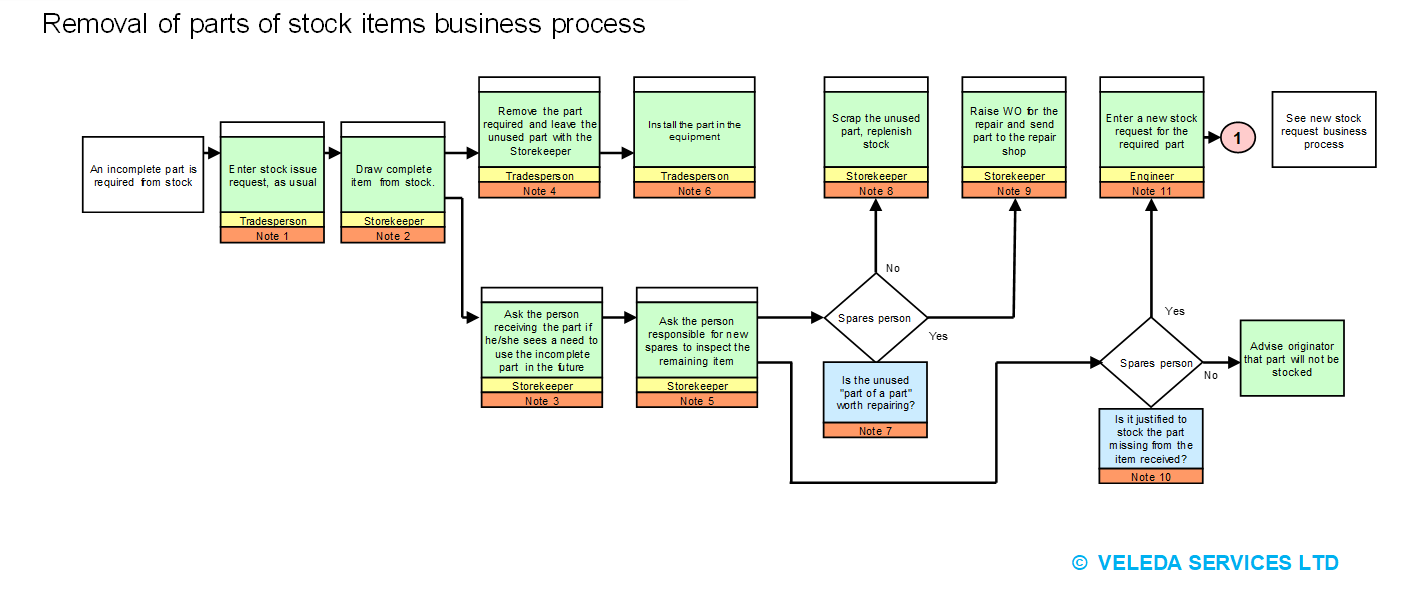An essential part of a complete business process for managing a maintenance storeroom is a robust and simple procedure for returning materials to Stores. The components of this procedure should meet the following requirements:
- It must be simple!
Returning parts to Stores is often a low priority for busy tradespeople, so to avoid loss and waste it must be very easy to return parts. The best method is to have a “Return” bin at the Stores counter or at designated delivery drop points so that the Stores person who delivers parts can pick up and return unused parts. Tradespeople must be trained to tag or mark returned parts with the work order number under which the part was issued so that the correct accounts are credited when items are returned to inventory. This does required some discipline and it should be the maintenance supervisor’s responsibility to ensure that this is done properly but it will not happen unless there is a procedure in place and it is used in training.
- It must take into account that some parts that are issued from Stores will probably be returned.
A prudent planner (or anyone else who plans a job, including tradespeople) will include all parts (and tools) that might be required in the work order kit. For remote repairs where the problem has not been clearly defined, it is wise to take the parts required to repair any one of the possible failure modes. For example, if a distant hydraulic system is not working, it may be wise to take a spare motor, coupling, pump, directional valve, oil, filters, etc, just in case they are needed. If it is found that they are not, they must be promptly returned to Stores.
A sound business process will ensure that the person who receives items that they may return from Stores advises the Stores attendant so that an appropriate flag can be raised in the SKU record. The maintenance computer should have the functionality to ignore such issues when a replenishment report is run, and to prompt a follow-up if the part is not returned within an appropriate period. If a manual system is in use, a card showing “Part borrowed by Fred Mechanic on 18 Feb 2018″ should be placed in the bin. I could argue that such a card system may be more reliable than using any maintenance computer system that I know of for this purpose.
- It must ensure that returned parts are fit for service.
During a Stores audit, I ran into an electrician who showed me two bins. One contained four I/P converters, and he had tested them all and found that only one worked. Another bin contained three limit switches, all of which had had their cam rollers removed.
Many important components, such as hydraulic valves, pumps and motors, electronic boards, etc, look exactly the same whether they work or not. To ensure that only good, reliable parts are available for issue in Stores, these components must be checked before they are accepted as returns, even if they have only been out of Stores for a very short time.
Of course, many parts, such as pipe fittings and other simple hardware may just need a visual inspection before return. On the other hand, some critical materials such as special steel stock or high pressure pipe may need approval from a qualified maintenance engineer, a utilities manager or some other expert to ensure that the returned material fully complies with all the relevant regulations.
Ideally, the maintenance computer should have a field that defines the testing (if any) required for each SKU. When a “return of stock” is entered the Stores attendant can then ensure parts have been properly tested to a documented standard and have a current “tested” tag before being returned to the bin.
An alternative is to use “tamper evident” packaging for parts where a visual inspection will not reveal any defects. For example, if heat-sealed plastic bags are used to package hydraulic, electronic and similar parts, they may be returned without inspection if the bag has not been opened. These bags must be clear so equipment labels can be easily read without damaging the packaging.
- Returned parts must be complete.
The above example of limit switches with rollers removed is a common Stores problem. Again, it can be controlled with a few simple rules that also need to be managed by Stores and maintenance supervision. A simple business process, the work flow for which is shown below, will improve Stores service (contact us for the full business process)

It is unusual to find a Stores operation that has all these “returns” procedures in place. However, if the Storeroom is focused on providing the best possible service to Maintenance there should be good general business processes in place to ensure that all materials in Stores, including returned and repaired items, are properly stored, properly identified and always in a condition that will meet your reliability goals.
To return to the Articles index click here.
© Veleda Services Ltd
Don Armstrong, P.Eng, President
don.armstrong@veleda.ca
250-655-8267 Pacific Time
Canada